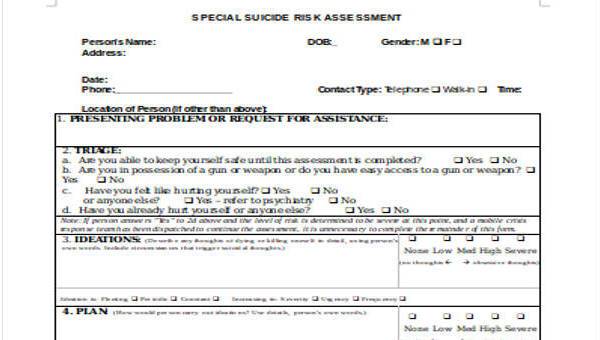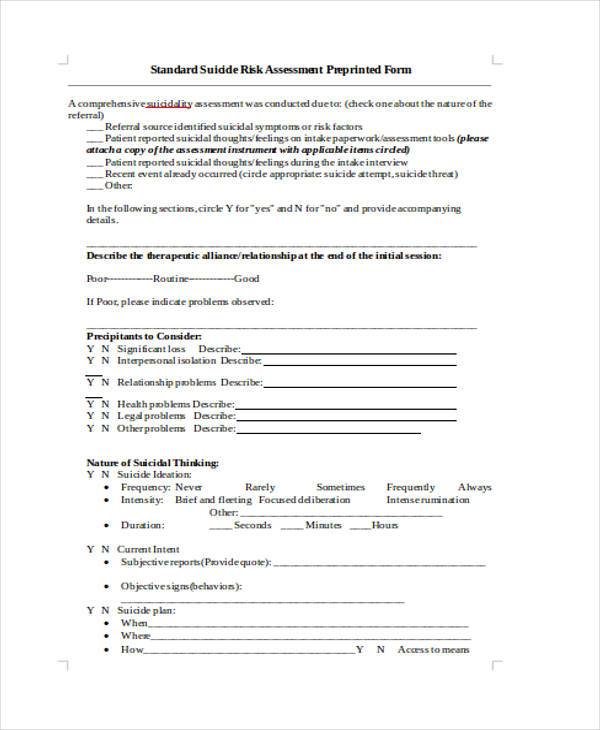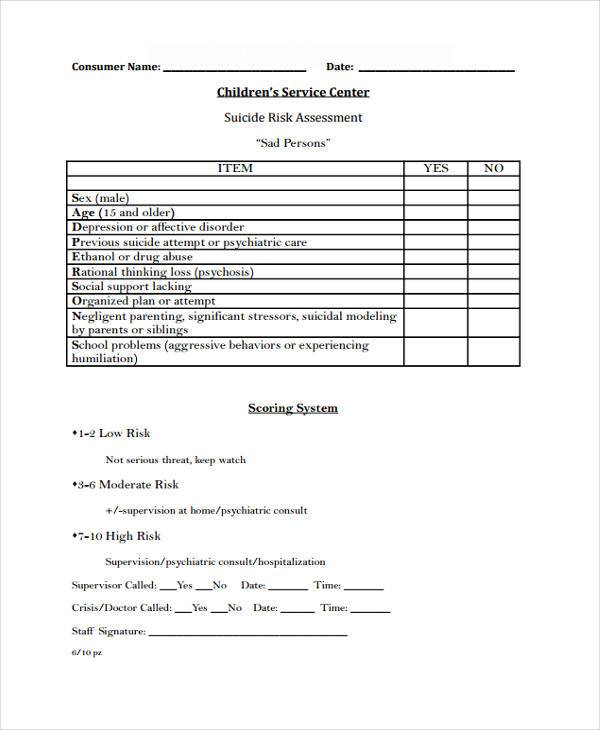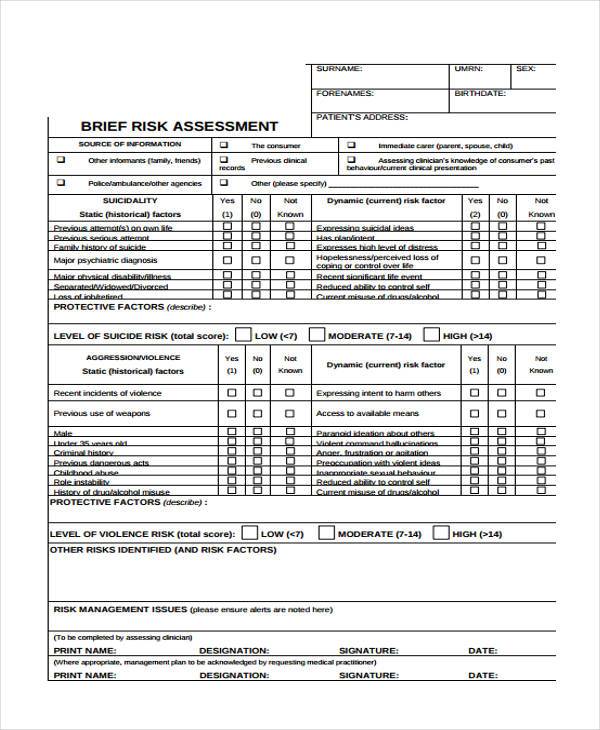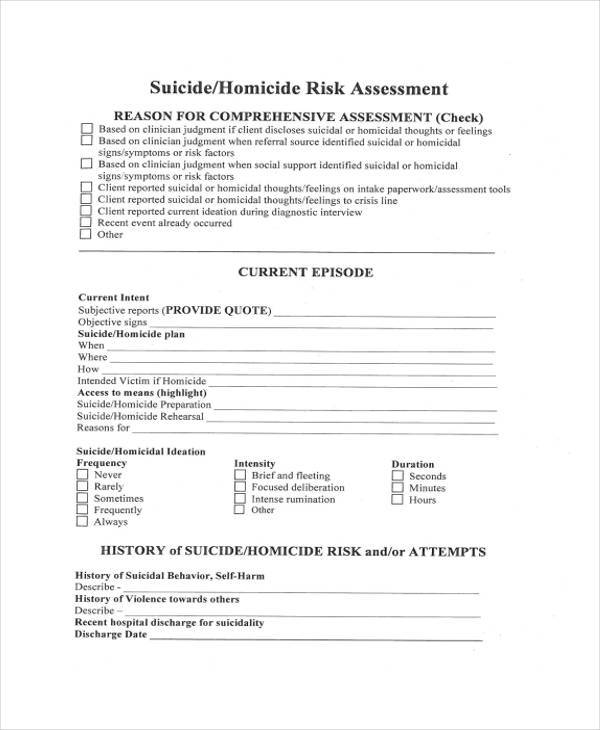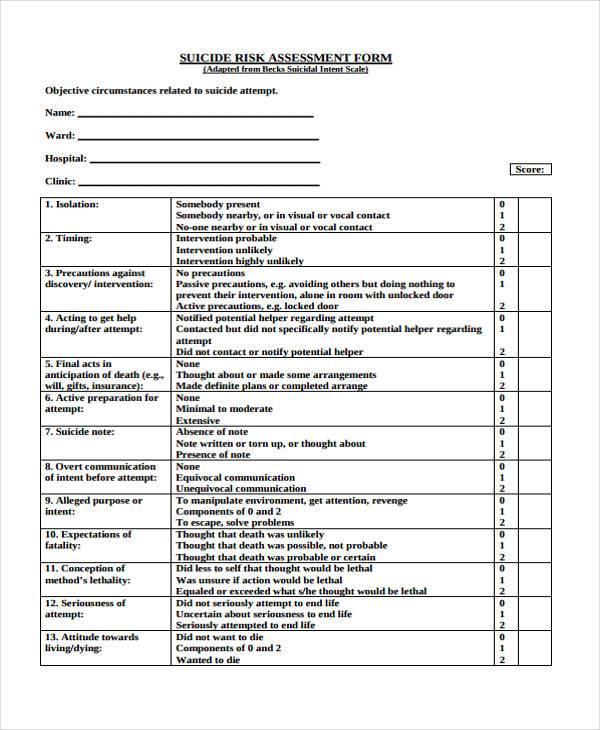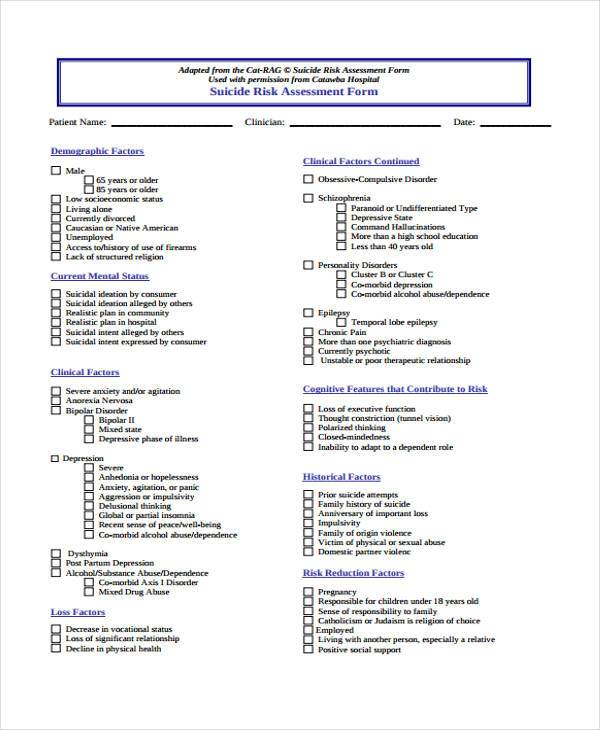According to studies, suicide is the third leading cause of death in the entire world and is the 11th cause of death in the United States. About 100,000 people commit suicide each year, and such cases are more common among men than in women. The rise of suicide instances is a concerning number that needs immediate attention.
A Suicide Risk Assessment is the act of evaluating an individual’s potential to hurt himself or cause his own death. A Suicide Risk Assessment is typically conducted by experts such as clinicians or health professionals. Suicide Risk Assessment Forms or Suicide Assessment Forms are usually used to document the results and findings of a Suicide Risk Assessment. You can also view our sample Assessment Forms for more Risk Assessment templates.
Standard Suicide Risk Assessment Form
Suicide Risk Assessment Screening Form
Child Suicide Risk Assessment Form
Brief Suicide Risk Assessment Form
Through Suicide Risk Assessments, clinicians and health professionals will be able to provide an estimate of the probability or the chances of a person committing suicide. The evaluation bases its results on different key factors that might lead a person to contemplating suicide. Some factors that cause a person to harm himself involve psychological disorders, substance misuse, stress, genetics, family history, or sociocultural elements.
Psychological Disorders
One of the leading causes of suicide is Psychological Disorders. Mental disorders such as depression, schizophrenia, and bipolar disorder are usually linked to individuals with suicidal tendencies, and depression is considered to be one of the front-runners for causes of suicides.
Depression is when an individual feels severe despondency and dejection. According to the World Health Organization, depression has rapidly increased its effect in over 100 million people in the last year and is one of the top psychological disorders that exhibit suicidal tendencies in a person.
Substance Abuse
Drug and alcohol abuse are the second leading causes of suicidal tendencies. Studies show that a lot of individuals who had been addicted to drugs or were alcoholics admit to having attempted suicide or inflicted harm on themselves; however, these people are at least 5 to 6 times more likely to report a suicide attempt.
Genetics
Mental illness or Psychological Disorders can also be revealed in a person’s genetic make-up. As a matter of fact, a recent study conducted by the Center for Addiction and Mental Health has found evidence of a gene variation that is connected with suicidal tendencies due to genetics.
Suicide Risk Assessment Form in PDF
Free Suicide Risk Assessment Form
Suicide Risk Assessment Form Example
Suicide Risk Assessment Form in Doc
Sociocultural and Economic Factors
Aside from Psychological Disorders, Substance Abuse, and Genetics, a person’s social, cultural, and economic environment also plays a big role in influencing his psyche. In fact, approximately 4,000 young people who are as young as 15 and as old as 34 commit suicide every year. A person’s family history, history of violence, physical or sexual abuse, and an exposure to suicidal behavior can greatly influence his personality and self-worth, thus resulting to suicidal tendencies.
Although it can be quite challenging to determine if a person has suicidal tendencies, some warning signs are usually exhibited to help you assess if a person is thinking of harming himself such as:
- A person who constantly threatens to harm himself
- A person who always talks or thinks about death
- Calling or visiting people to say goodbye
- Losing interest in things one used to be interested in
- Feeling of hopelessness
- Constant rage or anger
- Dramatic mood changes
- Lacking of purpose to live
- Recklessness
- Trouble sleeping and eating
Preventing suicide may not be an easy feat, especially if the person is an introvert or does not harbor any signs or symptoms of suicidal tendencies. Conducting a Suicide Risk Assessment is one of the best ways to control or prevent further suicidal tendencies or eliminate any attempt to inflict harm on one’s self. If you feel that someone has a potential of harming one’s self, ask them directly – some people who tend to be suicidal are usually just waiting for less judgement and more understanding.
Related Posts
-
FREE 7+ Sample Suicide Assessment Forms in PDF | MS Word
-
The Importance of Risk Assessment and Safety Statement [ What Is, How to Conduct ]
-
Risk Assessments And Safety Statements Guidelines [ What Is, Process ]
-
How to Fill Out a Risk Assessment Form? [ Steps, Tips, Purpose ]
-
FREE 5+ Training Risk Assessment Forms in PDF
-
FREE 4+ Control Risk Assessment Forms in PDF | MS Word
-
FREE 5+ Office Risk Assessment Forms in PDF | Ms Word
-
How to Conduct a Risk Assessment? [ With Samples ]
-
FREE 9+ Plant Risk Assessment Forms in PDF | MS Word
-
FREE 7+ Sample Health and Safety Risk Assessment Forms in PDF | MS Word
-
FREE 7+ Sample Caries Risk Assessment Forms in PDF | MS Word
-
FREE 7+ Sample Management Risk Assessment Forms in PDF | MS Word
-
FREE 7+ Fall Risk Self-Assessment Forms in PDF
-
Physical Therapy Assessment Form
-
FREE 11+ Assessment Forms for Teachers in PDF | Ms Word | Excel
